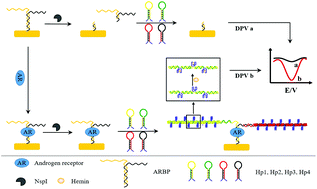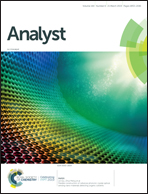Ultrasensitive detection of the androgen receptor through the recognition of an androgen receptor response element and hybridization chain amplification†
Abstract
An ultrasensitive electrochemical detection of the androgen receptor (AR) was developed based on the protection of a DNA duplex by the AR from restriction endonuclease-mediated digestion and a subsequent hybridization chain reaction (HCR). Two partially complementary DNA probes P1 and P2 were designed to form an androgen receptor binding probe (ARBP) through hybridization. The ARBP contains a duplex at one end and two single-stranded tails at the other end. The duplex part containing the recognition sites of the AR and NspI restriction endonuclease was immobilized on an Au electrode, whereas the single-stranded parts served as capture probes to activate the HCR. In the absence of the AR, NspI can cleave the duplex and release the capture probes, and thus, no HCR occurs. However, the AR can bind to the ARBP and protect the duplex from cleavage; therefore, the capture probes can trigger the HCR between four carefully designed G-quadruplex forming hairpin probes and the capture probes, resulting in the formation of numerous G-quadruplexes. Finally, differential pulse voltammetry (DPV) was carried out to quantify the AR. The assay revealed a detection limit of 7.64 fM. The verification of its high specificity and practicability in serum samples indicated its potential applications in the fields of clinical examination and disease diagnosis.



 Please wait while we load your content...
Please wait while we load your content...